|
|
 |
Has the Third Wave Really Spread throughout Japan? |
| Out of Respect for Kissa-Ten |
| |
Recently, there has been a trend toward creating new values in various industries.
In the fashion industries, there is a tendency among young people not to buy national brand products but fast fashion ones. More and more people have come to use online shopping to get a book (or even electric book) rather than in a book store, and a number of book stores have closed down or changed into multi-brand bookshops.
This tendency is most obvious on those industries in which continuous innovations are delivered, including the coffee industry in the "Third Wave".
Although we have already introduced Third Wave Coffee before, I would like to jot down some notes of some remarkable third wave cafe here since I had an opportunity to visit West Coast of the U.S., which is the birthplace of it on the other day.
|
|
 |

They have been a good seller at their online business as well, and they have kept roasting and packing their products all the time. (Blue Bottle Coffee) |

They are hosting a coffee cupping everyday at the cupping lab right next to the roasting plant. (Blue Bottle Coffee) |
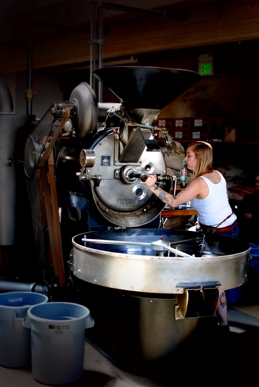
They have provided a probate nearby the gate, and were continuously kept roasting while our visiting. (Sight Glass) |
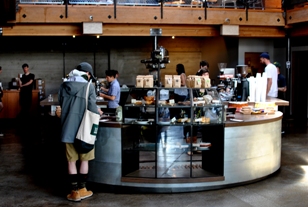
Their symbolic main retail counter. Many of the third wave cafes often have their counter in the center of the cafe. (Sight Glass) |
|
 |
In the West Coast, there has been a great revolution of third wave cafe. While some cafes are opened one after anther with a capital of a major SNS market, other cafes are took over by another one. It does not mean that coffee business there has been unsuccessful, but it seems they have been continuously reorganizing the market to make the wave bigger. In fact, we could also find blanches of various third wave coffee shops from the West Coast.
|
| |

Most of their cafe menus consist of espresso. As for a drip coffee, they treat it as an advanced menu, and they brew coffee at another counter for each order. (Four Barrel) |
|

Quite a few founders of third wave coffee shops are from the West Coast. (Four Barrel) |
|
 |
It seems that the way of thinking "how third wave cafe should be" are different between the West Coast and the East Coast.
Generally speaking, most of the coffee shops in the West Coast are often provided with large site and lots of tables, and you will see a lot of nomad workers with their MacBook. While most cafes in the West Coast provide us our "third place" as it has been remarkable since the third wave started, those in New York are commonly a place to "drop by", and mainly offer coffee for take-away.
|
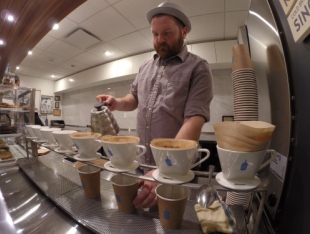
They unify all the equipment in Japanese products. (Blue Bottle Coffee)
|
|
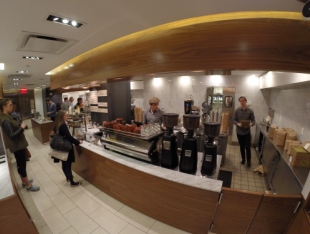
Their shop in Rockefeller Center has a small frontage, and long and narrow shaped. Most of their costomers take out the order rather than staying at the tables inside. (Blue Bottle Coffee) |
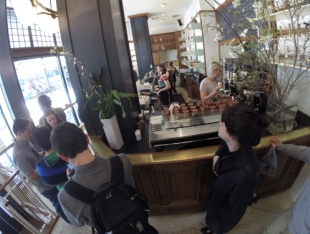
Most of their cafe menus are for take-away. (Stump Town)
|
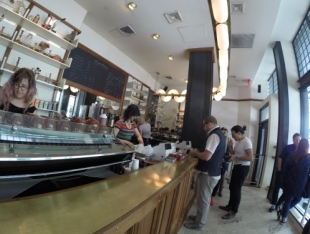
The branch of a well-known roaster from the West Coast has been flourishing at all times. (Stump Town) |
|
 |
Although it is hard to differentiate their own third wave cafe from other coffee chains unless they offer a "third place", most of third wave cafes aim at those in New York. Here is are some key elements of a success. They have succeeded in establishing the new concept into the coffee business, which is to simply pursue better taste of coffee.
I wonder "the standard for the coffee tastiness" has been vague for a long time. The types of coffee is diverse as well, from canned coffee to cappuccino with latte art. However, "the standard" has finally come to be shared as a common sense within this 20 years - and this must be the essence of the Third Wave, I guess.
|
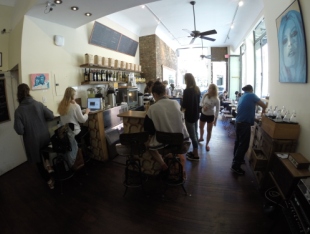
This is a special shop which offers a variety of coffee from each companies. There are some lithographs of Andy Warhol on the wall for the interior design. (Whynot Coffee) |
| 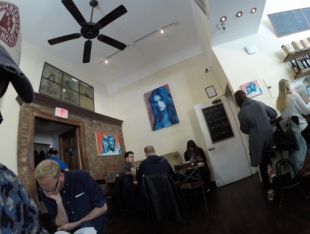
Although this shop lays in front of a residential street like the one in Oslo, they have tables in the second floor as well, and a variety of cafe menus with foods and alcohol. (Whynot Coffee) |
|
 |
| "The First Wave" had spread out Japan around from late 1960's to 1970's, and it caused the boom of "Kissa (cafes)" throughout country. However, it was not "a pursuit of beauty" but "to share somewhere to do nothing" which was emphasized. On the other hand, those "Seattle cafes" that have prospered in the Second Wave had succeeded in offering "third places", other than our home or workplace, "to do something", plus they have put the concept of "enjoying coffee" in it. Now it is obvious which concept has been successful in the end, after looking the decline of Kissa culture and the present American coffee culture. Therefore, Third Wave Cafe may be called "Neo-Second Wave" as well in the respect that it was greatly influenced by those independent cafes in the Second Wave. |
| |
| 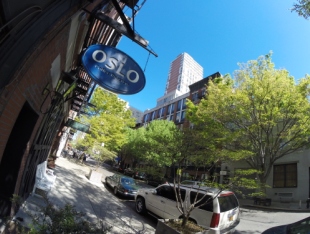
This shop lays in a quiet residential area in the outskirts of Manhattan. (Oslo Coffee) |
|
| 
Despite its location in a residential area, they offer coffee only for take-away. |
|
| |
Through this inspection of third wave cafes, I have found a common fact that I had not expected.
What those independent third wave cafes have put focus on is to presenting "coffee as fruits" and creating "the standard of tastiness". It consists of various selections of single origin, terroir, species, and the cupping score sheet which visualized the "tastiness of coffee".
The coffee business had lacked in this concept for a long time because its merchandize was based on sales distribution. Rather than that, it had not been functioning as an organizer to share consumers latest information of new way to enjoy coffee that the technological evolution in coffee production, purification, and transportation had brought. With sidelong glances at old cafes or roasters falling behind, third wave cafes have started advancing rapidly. Moreover, most of them have established a concept of "selling specialty coffee" as well.
Although this "big wave"should be an ideal form of the coffee world, there is something I concern as well.
|
| |
Have you heard of this word?
"Any genre is districted by an enthusiast."
There is a common strategy among those who try to make new wave in their business. It takes both cost and risk to make a big wave within a short time. So they first create a small market which is subject to a minority (=fans), and gradually start making it bigger. At this time, it comes to be pretty important as making it big to cut the marketing for fans down, and switch it for majority (=general use) without pausing. Although new genre hits those fans who love something "different" or "exclusive", but the market will be declining if it encloses only those fans as it has no effect on the majority (and this is more remarkable in fashion and music industries which need to continuously create new genre.
I think the Third Wave in Japan has been just on the point of set it. In reality, however, there has been just those cafes that focus on only its design or original concept, enclosing a minority too much. If they do not understand "the elements of the third wave", it should be negative to Japanese coffee culture after all.
How should we apply it to Japanese coffee culture then? One of the answers may be the Kissa (Japanese cafes) which is deeply rooted in our culture.
In the first place, the way to enjoy coffee is different between Japan and the U.S. (it's natural since it's different even between the West Coast and the East Coast). Therefore, there is impossibility to apply it into our culture as it is. Eventually, only the Kissa culture may develop and play a part of the Third Wave, I think.
I had an opportunity to meet person who was a chief roaster of a third wave coffee company which was planning to open a branch in Japan in 2014. He said he had respected the Japanese Kissa culture. Although it is a famous story among coffee business that the reason he has started the business is Japanese Kissa culture, beyond that, I felt his extraordinary longing for Kissa culture and determination. The Third Wave has a potential to push the times forward. So we should not neglect the fortune which is respected by a group who plays a great part of the wave, I think.
|
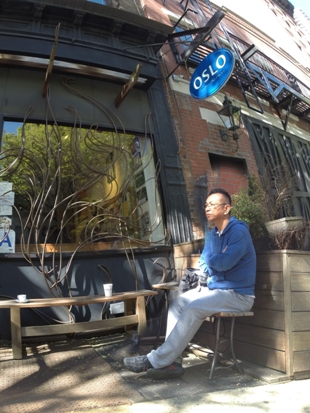 |
|
|
Apparently, now "convenience store coffee" has been a global prevalence since its great hit in Japan (they had sold 1 billion cups of coffee in 2013!).
The convenience store coffee which has made a dramatical growth in a year, and the third wave cafe which only "some people know". While the former is totally rationalized product, the latter is required added value in service, so these seem to be classified in that point. However, I cannot say there would not people enjoying coffee, on sofa at a convenience store after a few years.
Does the Third Wave really fit to Japanese coffee culture eventually? The answer will come out in the near future. I hope there will be new form of coffee culture, "Japanese Third Wave", making a good use of Kissa culture at that time.
|
| |
Hiro Coffee Co., Ltd.
Mitsuhiro Yamamoto, Representative Director |
UP▲ |
|